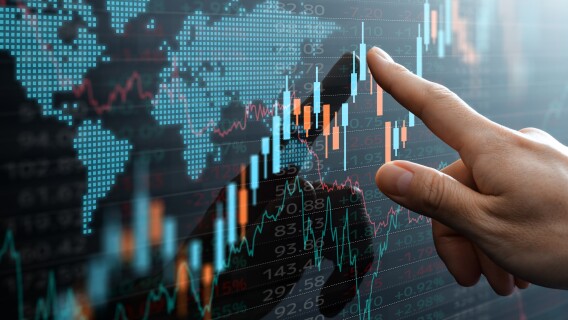As we approach the end of Q1, the performance of many international developed markets is trumping that of the U.S.
This is causing some market observers to reconsider the “stay home” investing strategy that has worked so well over the last decade.
What exactly is going on, can it continue, and if so, how can you best build exposure through small-cap ETFs?
Why International Developed Markets Are Outperforming
Trump’s tariffs are a big reason for the performance discrepancy. But the broader style of disruptive governing is also having a major impact. The market just doesn’t like uncertainty.
So far, all of this seems to be having a limited (or positive) impact on most European stock markets, where a number of countries are planning significant domestic spending projects. Germany is just one example. The country just unveiled a $1.3 trillion spending pledge aimed at reversing years of economic decline.
Germany’s DAX is up 26% over the last six months versus around 6% for the S&P 500.
ECB leaders have also been talking about significant investments in AI and bolstering defense spending. The Trump administration has called for the EU to take more of a leadership role in this area as well.
[text_ad]
The ECB has also been slashing interest rates (most recent cut was last Thursday), and the currency is strengthening against a weakening U.S. dollar. Europe’s Euro STOXX 50 is up 15% over the last six months.
But it isn’t the only overseas market doing well. China’s Shanghai Composite (+22%) and Hong Kong’s Hang Seng (+39%) are also way ahead of the U.S. over the last six months.
On the other hand, many emerging markets, especially those that will take a hit from Trump’s tariffs, are doing poorly.
With a disruptive administration, it appears that, after a decade or so of investment dollars flowing into the U.S. market, the big money is saying it’s time to take a more global strategy.
How to Gain Exposure
There are, of course, a ton of ways to gain international exposure with individual stocks.
But my guess is that the average investor seeking significant international exposure doesn’t want to deal with company-specific risk. Especially not these days.
This is likely true for those seeking international small cap exposure as well.
Here are six international small-cap ETFs that can get the job done.
Six International Small-Cap ETFs
iShares International Small-Cap Equity Factor ETF (ISCF)
This ex-U.S. developed-market ETF focuses on equities scored on four style factors: quality, value, momentum and low volatility. It has $313 million in assets under management (AUM), launched in 2015 and has an expense ratio of 0.23%. It is heavily focused on Europe (40%), APAC (38%) and the Americas (18%), with significant sector exposure to financials (25%), manufacturing (11%) and tech (7%). The ISCF yields around 3.4%. The stock is up 6% YTD and 12% over the last 12 months.
iShares MSCI EAFE Small-Cap ETF (SCZ)
SCZ is a much more popular fund than the ISCF, as evidenced by having $9 billion in AUM. It’s also been around longer, having launched in 2007. The expense ratio is a little higher at 0.4% and the dividend is a little lower, at 2.9%. Interestingly, the fund’s performance isn’t much different from that of the ISCF lately, having returned 6.6% YTD and 9.2% over the last twelve months. Geographic exposure is a little different (though not much), with 47% in APAC, 34% in Europe and 14% in the Americas. The SCZ is heavy on financials (25%), industrials (18%), materials (11.3%) and tech (9.4%).
iShares MSCI Europe Small-Cap ETF (IEUS)
The IEUS has a YTD gain of 9.8%. Over the last year (+11.3%), its performance nearly matches that of the ISCF. As the name states, this is a Europe-focused fund (67% weight). The IEUS allocates 18% to the Americas and 9.9% toward APAC. Financials (28%) and industrials (21%) are the two biggest sector weights. The IEUS is not a hugely popular fund, with just $94 million in AUM. But it yields nearly 3% and has been around since 2007 and its European focus may be just what some investors are looking for.
WisdomTree International SmallCap Dividend Fund (DLS)
WisdomTree’s DLS ETF isn’t the biggest small-cap fund out there but it has $900 million in AUM and has been around since 2006, so it’s relatively well-known. The dividend yield is at the high end of this group at 4.7% and recent returns are solid as well. The DLS is up 9.7% over the last year and 6.3% YTD. Geographic exposure is heavy on APAC (42%) and Europe (40%), with financials (22%), industrials (18%) and materials (12%) the three highest sector weights. It pays a dividend of 4.7%.
Schwab Fundamental International Small Equity ETF (FNDC)
Schwab’s small-cap international funds are among the best-performing out there. The FNDC has returned 10.6% over the last year and is up 7.7% YTD, making it the best performer of this group in 2025. It’s not small: FNDC has $3 billion in AUM, and it offers a respectable dividend yield of 3%. Geographic and sector exposure is similar to the DLS from WisdomTree, though FNDC has a little more APAC (49%) and a little less Europe (28%). As the name suggests, the ETF has a fundamental focus. Firms with the right mix of adjusted sales, operational cash flow, dividends and buybacks are the focus.
Schwab International Small-Cap Equity ETF (SCHC)
Schwab’s SCHC ETF ditches the fundamental focus and simply covers the bottom 10% of the eligible universe of stocks in the FTSE Developed ex-US Index with market caps over $150 million. The lack of a fundamental screen hasn’t hurt much lately. The fund is up 9.6% over the last year and 6.2% YTD. It is 25% larger than the FNDC in terms of AUM at $4 billion. Compared to the FNDC European exposure is a bit higher (34%) and APAC a bit lower (33%). And again, sector exposure is heavy on financials (23%), industrials (18%) and materials (13%).
Which International Small-Cap ETF to Buy?
Any of the above small-cap ETFs should work for their intended purpose. My suggestion would be to pick a mix of two or three, making sure to get at least one that’s either fundamentals- or dividend-focused.
As always, averaging in makes a lot of sense, especially in a volatile market.
[author_ad]

